Strauss: Oboe Concerto
Despite his advanced age and the chaos surrounding him, Richard Strauss remained highly productive well into the 1940s. As the Second World War was coming to an end in 1944-45, the eighty-year-old composer was working on his Oboe Concerto and Sonatina No. 2 for winds, as well as the Metamorphosen for strings. While the latter work was an explicit response to the destruction Strauss was witnessing, in the Concerto and the Sonatina the composer seemed to be turning his mind away from the events surrounding him. There is a pastoral quality to the oboe concerto, with a highly tuneful solo part and more than occasional touches of nostalgia for the 18th century. Similarly, Strauss headed the score of the sonatina with a dedication ‘to the spirit of the immortal Mozart at the end of a life full of thankfulness’.
To an extent, one might say that Strauss at the end of his life returned to the musical models of his youth. It is therefore fitting that these two works frame the Serenade in E flat major for wind ensemble, composed more than sixty years earlier in the tradition of entertainment music by Schubert and Mendelssohn.
